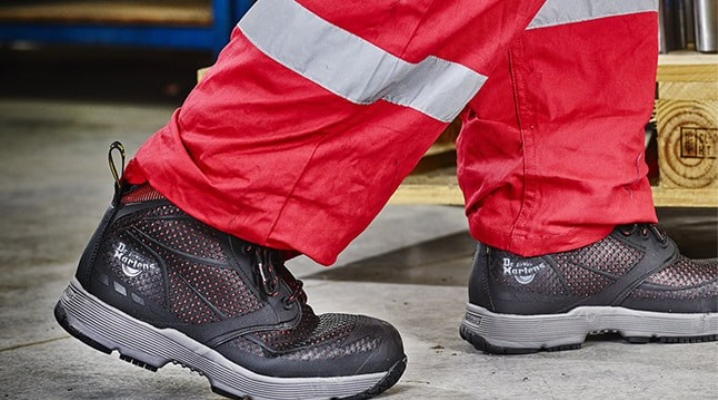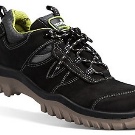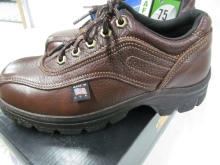Varieties and selection of safety footwear

It is impossible to confine oneself to the protection of only the body and the head in real production conditions. Be sure to protect your legs. That is why, for a wide variety of professionals, knowledge of the types of safety footwear and the features of its choice is extremely important.

Norms and requirements
Overalls and PPE, other components of the protection of company personnel should be purchased at the expense of the companies themselves. Ultimately, it is the companies that are interested in their employees staying productive longer and ensuring the fulfillment of the assigned tasks. That's why it is imperative to be guided by the official standards when choosing special footwear of any type and purpose.



It is, of course, carefully sized. But it's not only that.
Each technological operation in the manufacture of special footwear has its own separate GOST.
Special standards have also been introduced for transportation, storage in warehouses, acceptance and marking.
Standardized:
the thickness of the top and bottom parts;
adhesion strength of the heel;
tensile strength;
the strength of the seams on the workpieces;
hygiene indicators;
weight of packing places;
service life of work shoes;
silhouette;
the temperature of the skin on the foot;
interior finishing characteristics;
external appearance.






To comply with labor protection standards, shoe personal protective equipment is classified according to resistance to:
abrasion;
puncture force;
vibration effects;
slip;
intense heat;
thermal radiation;
open fire;
sparks;
drops and splashes of molten metal;
low temperatures;
contact with electric current;
electromagnetic fields;
toxic particles and environments.





Views
Special footwear, however, is not always designed for use in particularly harmful and dangerous conditions. Even during normal office activities, specific problems arise, from which the legs must be protected.
With the help of shoes and sandals, this problem is solved:
in office buildings;
in cafes and restaurants;
in kitchens;
at textile factories and other light industry facilities.


In the catering industry, you sometimes have to spend many hours on your feet. Therefore, orthopedic characteristics and the quality of ventilation and moisture removal are of great importance. It is equally important to maintain a pleasant appearance of employees, because they will be judged on the whole company as a whole. Many options for shoes for the kitchen and similar objects are made of high quality leather or yuft.
If the purpose of the shoe is to be used for sanitary, hygienic purposes, in medical and veterinary services, in showers, it will most likely be made of various types of rubber.
Leather safety shoes have the widest profile. But it is important to understand that it also has a number of restrictions on its use. Only a few leather pieces are sewn entirely at once. Usually, the leather is placed on top, and the bottom is made of rubber and other materials. All-leather safety shoes are needed mainly where explosives are constantly present.

Summer
This type of equipment involves the use of a metal or synthetic toe cap. Composite materials are most often used. Since operation at elevated air temperatures is envisaged, heat dissipation and micro-ventilation are very important.
For work in the summer, open or partially open shoes are usually used. But all the same, the designers are trying to do so as to protect the legs from sudden mechanical influences of various kinds.
Even a sudden blow must be successfully repelled.
Antistatic properties and resistance to moisture ingress are still relevant. The difference between specific types of summer safety shoes may also be related to its size. A wide range of sizes is now produced, especially for men. For women are intended:
shoes;
sandals;
boots.



Winter
In this segment, cold resistance and moisture containment are already at the forefront. But winter conditions also impose other requirements, first of all, stability on slippery surfaces and easy passage on loose snow. For relatively mild weather conditions, it is sometimes limited to sneakers or ankle boots. However, for severe frosts, you already need:
felt boots;
insulated boots (with fur or with thick membranes);
high fur boots;
multi-layer rubber footwear, combined with other materials and with an increased level of protection against extreme cold.



Materials (edit)
The outer parts of special shoes are usually leather or made of leatherette. In this case, there may be fur inside, some kind of synthetic or natural fabric. In theory, the continuous application of leather wherever possible would improve the quality of the shoe to the maximum. But for financial reasons, no one will do that. Therefore, fabric linings are most often used.

PPE based on yuft (combined tanned leather) are widespread. This material is mechanically strong and completely safe in terms of the environment. However, it can hardly be considered a particularly aesthetic solution. Therefore, yuft is usually used for footwear designed for aggressive environments. And somewhat less often it is needed for outdoor work.
Chrome skin is much more attractive in appearance, and in terms of basic characteristics it is not bad. There is only one minus - this material is significantly more expensive than leather. Due to the attractiveness of the price, splitting is becoming more and more widespread. It can be used (depending on the specific variety) for both the inner and the front surface. If the lowest cost is important, artificial leather is used, but its protective properties are relatively low.
The sole is most often made on the basis of:
nitrile;
polyurethane;
thermoplastic elastomer;
PVC.





For work in winter, the most attractive solution is natural fur lining. But its widespread use is hampered by the relatively high price. Therefore, products with artificial fur or even with composite insulation are becoming more widespread. Since the technological problems have been generally resolved, the use of these materials does not cause any particular risks. And their rejection has a lot to do with the force of habit.
In places with high humidity, it makes sense to use rubber PPE. But you need to understand that the standard options for such shoes create a bad microclimate for the foot.
It is necessary to give preference to newer and more relevant developments.


The difference between shoe options can also be related to the way the sole is attached to the upper. The glue method is appreciated for its extraordinary high strength and stability, even under adverse conditions.
The inner element is attached to the welt on a special sewing machine. The outer parts are glued with a special glue. To make the connections stronger, a nylon seam is additionally used, which is almost impossible to break. The glue-stitching technique involves first gluing the sole to the edge of the workpiece. After that, the shoes go to a high-class sewing machine, where the plantar sides are sewn with reinforced lavsan thread.
The glue method for the production of special shoes is used extremely rarely, it is mainly needed for ordinary everyday products. But they often resort to using the injection method.
This approach involves the penetration of polyurethane (its permeation) into both the bottom and the top of the shoe. Such a solution allows to increase the resistance to moisture and aggressive substances. The multiple increase in the contact area ensures exceptional solidity.
Importantly, this does not compromise the flexibility of the finished structure. But the technological process is simplified - you do not need to use additional glue or threads... But shoes with a metal toecap are used where increased mechanical loads are created, where there are many sharp objects and cutting surfaces. A slight increase in price allows the overall service life to be increased several times. In most models, an extra thick tread with increased shock absorption properties is used.



Marking
This point is especially relevant already because in Russia since 2018 (more precisely, from July 1) all manufacturers and suppliers must take care of the labeling. It applies not only to special shoes, by the way. The basic designations must correspond to the two-dimensional code according to the Data Matrix standard. Additionally, a special sequence of letters and numbers with a total length of 31 characters is used.

Marking must be done on sale prior to final shipment from the manufacturing facility. If shoes are imported from the EU, then they must have special designations at the time of crossing the border of the Russian Federation. The main properties are indicated by additional letter combinations:
Мп - protection against punctures and cuts;
Ma - vibration resistance;
Moon (number) - force of impact to the forefoot in KJ;
Mut (number) - the force of the blow to the back;
Mule and Moob - strikes to the ankle and shin, respectively;
Сж - reduced sliding on fat;
SL - small glide on ice;
Cm - minimum sliding on wet, dirty and other surfaces;
Тн - protection against negative temperatures;
Yazh - resistance to liquid toxic substances;
Oa - isolation from organic solvents;
Нт - for contact with solid petroleum products.



Popular manufacturers
Quite a few companies in different countries are engaged in the production of special shoes. But still, there are clear leaders among them in terms of quality and variety of products. In our country, this is the firm "Tract". Its goods are actively shipped abroad. A number of shoe models are made using nitrile rubber, non-metallic puncture-resistant insoles.
You can find options:
for welders;
for working with petroleum products;
for staying in a particularly aggressive environment;
for work with energized communications.




But in Russia there is also another top-class manufacturer - the Tekhnoavia company.
Contrary to its name, it produces by no means only what is needed for aviation and aircraft construction.
The range includes winter, summer, demi-season PPE for legs.
The official catalog also widely includes:
footwear for medical needs;
footwear for people with large feet;
white equipment;
products with composite inner socks;
leather shoes for men and women;
boots and boots with fur lining (and this is just a small part of the range).






Finnish factories also produce excellent safety footwear. Among them, Sievi deserves special attention. The brand was born in 1951 and has managed to become a firmly leading manufacturer of foot-operated PPE in northern Europe. The enterprises employ about 500 people, and significant production volumes are achieved through the use of automation. The company has a laboratory for the production of the most complex tests.
Naturally, the company focuses on the winter segment.However, Sievi also produces ESD footwear, which is characterized by minimal build-up of static electricity.
Summer and demi-season segment is represented by:
sandals;
low shoes;
work shoes with and without a metal toe cap;
models with anti-puncture insole;
models with a metal insole (and all of these options are resistant to oil, gasoline).





American safety footwear is also quite widespread. So, Frye brand products has been on the market since 1863. Of course, during this time, a lot has changed in technology. However, the presence of a thick leather upper and a durable rubber base has proven itself for decades. Such products do not look very presentable, but they will work for a long time.





Thorogood brand made a name for herself just on work boots and boots. The reviews note the convenience of landing a leg. Also, attention is focused on the resistance of the outsole to slip.



Many people still choose products:
Chippewa (USA);
Cofra (France);
Pezzol (Italy);
Reis (Poland);
Ahiless Safety (Russia);
Ewest (Republic of Korea).






Selection criteria
Of course, safety footwear should be as convenient and comfortable as possible for those working at a particular facility. A seemingly momentary distraction and constant mental fatigue can become the very accident that will lead to injuries, accidents, or "just" will not allow you to do the job accurately and on time. It is equally important to take into account the aesthetic side.
Regardless of the purpose of use, safety shoes must:
to carry vibrations with a strength of 2 dB (for a frequency of 16 Hz);
to carry vibrations with a force of 4 dB (at frequencies of 31 and 63 Hz);
protect from blows to the toe with a force of at least 5 J;
have shields that absorb blows to the ankle with a force of at least 2 J;
be equipped with a sole with a hardness of at least 70 units on the Shore scale.





But the general requirements are far from all. It is necessary to take into account the nuances of a particular specialty. Builders are usually advised to use boots. Models with a three-layer construction can be used well during the winter months. Then boots made of thick felt are also suitable.
In the warm season, it is advisable to use leather boots with protection against punctures and impacts. The problem is that they are not suitable for welding and other operations where molten metal can appear. Welders need to wear leather boots with a tightly closed tongue. It will not allow hot metal to get inside. But if there is much more metal around (in the foundry, for example), then you should wear boots with elastic tops.



Leather boots with high ankle boots are almost a universal option. They are equipped with a built-in tongue. Most often, leather or even chrome leather is used for sewing. These boots can be used for heavy work indoors and outdoors. The grip of the outsole minimizes the risk of falling even on ice.

Asphalt paving is usually carried out in leather boots without a tread, but with a thickened sole. Such shoes will not fall even into a thick loose layer of asphalt concrete. What is important, there will be no traces on the road surface either. Designers today achieve reliable foot protection even at asphalt temperatures up to 270 degrees. But when facing work, they usually try to buy the most lightweight shoes.

For a warehouse, they usually choose special footwear designed for maximum loads. The list of requirements is determined by what specific items and material values are stored in the warehouse. Depending on this, you may need:
resistance to petroleum products;
protection against toxic substances;
immunity to cuts and impacts;
shielding from caustic reagents, acids and alkalis;
the minimum level of slipping and some other parameters.



Operating tips
Safety shoes must be used strictly in accordance with their seasonal use. Leather specimens get wet, albeit slightly, and this must also be taken into account. It is impossible to violate the regulations that are announced by marking or entering in the accompanying documentation. When the period of wearing is over (after the end of work or at the end of the season), the shoes are cleaned, washed and put in order.
It is impossible to use punctured, burnt, mechanically deformed or chemically damaged personal protective equipment.

Shoe and take off safety shoes, you need to take care of them in the same way as in normal cases. Cleaning should be carried out only by means and methods that are safe for a particular material. Do not use organic solvents for cleaning, even if the shoes are declared resistant to them.
It is highly undesirable (except in particularly important situations) to be in shoes for more than 9 hours without a break.
After infection with poisons, radioactive substances and biological agents, specific disinfection is imperative.

An overview of the boots from the Technoavia company in the video below.













The comment was sent successfully.